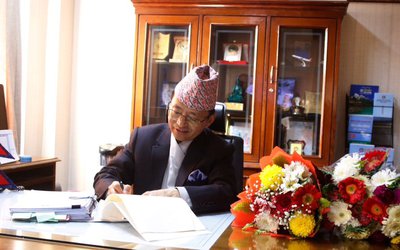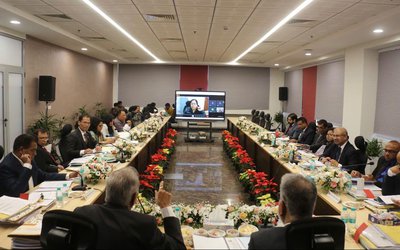
As you have celebrated the bank’s silver jubilee recently as a leading and successful financial institution of Nepal, what plans do you have for another twenty five years?
In the next twenty-five years, Himalayan Bank will definitely need to be doing more like mobile banking. The bank will need to focus on improvement of infrastructure as per the demand, particularly in the context of changing functioning of global financial institutions.
How do you see the state of the banking sector now compared to twenty five years ago?
The financial sector has remained competitive all the time. What I can say is that there is more intense competition now compared to twenty five years ago when there were fewer banks. There are some areas of competition where risk taking is quite high. For Himalayan Bank, it has its own system and risk taking capital is not as high as it is with other financial institutions. That is one area where our bank is not competing. Nepal Rastra Bank has also recognized that there are more problems in the banking sector. They have introduced more regulations to check the risk areas.
You were together with your father when Himalayan Bank was established, how was the situation then?
When we started the bank, our capital was 60 million rupees only. Even raising such a capital was quite difficult. My father had approached many people to raise the capital. However, they did not believe that we could run the bank. Competition was there for joint venture banks and the situation was not rosy at that time as new banks could come and capture the market. French joint Venture Indo-Suej Bank, Standard Chartered and Nabil Bank were there. However, we were able to establish our reputation in just over ten years and we became a reputed bank.
How do you see the situation now?
Our bank has improved considerably and we innovated a lot of products. We brought SWIFT and Visa credit card to Nepal. We are the first bank to have introduced ATM here. There are many milestones for the new bank. Our bank also contributed to establish NBA and trading houses and played a key role in providing infrastructure to all the private sector commercial banks.
Having such a long experience of working in the banking sector, how do you see the current cash crunch?
Lending growth has always been there. The problem here is political uncertainty. Once the new government comes into place, there will be a certain sense of stability and the formal sector will be active and current cash crunch will be solved.
Besides that, there is the need to increase the government spending which is too low now. After the new government is formed there will likely be an increase in government spending. The situation will be likely to improve.
As Rastra Bank has been blaming the financial institution’s policy for the present crisis, how do you look at this?
Nepal Rastra Bank can do so much. It has been saying that forty percent of the loan has been in the unproductive sector. They are saying that a mismatch is there, including investment in shares and real estate. That is the market situation. Nepal Rastra Bank has also been talking with Finance Ministry to change laws so that the money with government can be deposited in the commercial banks. Nepal Rastra Bank has been doing its job.
As Nepal’s remittances have continue to decline over the last few years, how will this affect the banking sector’s lending and deposit?
It will have implications in deposit and lending. The situation was not good also in 1994-95 when Himalayan Bank was just established. It is good to say that Nepal Rastra Bank has started dialogue with banks about the situation. This is a very encouraging sign.
How do you see the human resources?
Human resources have been one of the big constraints now. We have also lost quite a number of trained manpower which hampered our expansion plan. I am happy to say that the board has accepted our plan to go for digital side of banking, leaving our old model. This means we will require fewer human resources.
What is the deposit ratio of the bank?
Sixty percent of our deposit is retail and now we are diversifying our deposit areas. Our 70 percent lending is in corporate sector and 30 percent elsewhere. We have such a huge trade finance transaction. We don’t want to lose our advantage on that. We always have a huge portion on that.
How do you see the challenges?
The challenges before us is to keep on the present capital that we cannot grow. There are other banks which have more in capital than we have. We need to increase our capital. Until that time, we need to move on. Our dividend policy will be to give some more bonus shares and some cash.
- FM DR.RANA INDIA VISIT: Strengthening Relations
- Jan 02, 2025
- BUTWAL-HETAUDA Connected By 220 kV
- Jan 02, 2025
- PM OLI' CHINA VISIT: A Success For Business
- Jan 01, 2025
- ISRAELI AMBASSADOR SPEAKS: Israel For All Possible Support To Nepal
- Jan 01, 2025
- NEPAL-INDIA ENERGY TRDE: A Silver Lining For Nepal
- Dec 31, 2024















